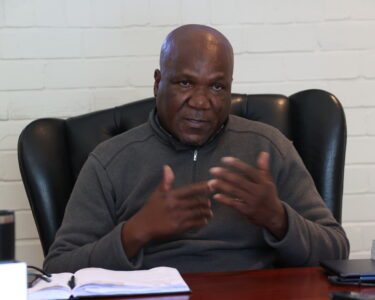Whenever the Minister of Mines and Mining Development, Winston Chitando, talks about achieving the US$12 billion target by 2023, he always emphasises that the gold sector will contribute significantly to that target. In 2021, gold deliveries to Fidelity Gold Refineries topped 29.5 tonnes while in just nine months, from January to September in 2022, the sector had already delivered 25.7 tonnes.
The gold sector is now valued at around US$5.2 billion, a clear indication that the industry has been growing exponentially over the past four years. Many observers have been wondering how the gold sector has managed to blossom so much over the past few years.
Our Editor-in-Chief, Munyaradzi Huni, recently visited Pickstone Peerless Mine in Chegutu and got a sneak preview of how and why the gold sector has become one of the biggest contributors to the US$12 billion target. Owned by Dallaglio, Pickstone Peerless Mine has embarked on an expansion project that will see the resurrection of some of its mothballed underground mines. This expansion project is expected to double gold output from the current average of 40kg to 80kg per month. In 2023, the company projects to produce 850kg of the yellow metal.
No wonder Minister Chitando is optimistic that the sector will contribute significantly towards the US$12 billion mining economy. The Pickstone Peerless Mine story is enough to instill confidence. Read on . . .
Pickstone Peerless Mine is located approximately 120km southwest of Harare and 20km southeast of Chegutu. The mine is situated in an area that has historically been known to be extremely rich in gold deposits with production records dating back to 1907.
Over the last 115 years of its existence, ownership of the mine has changed with Rio Tinto, Delta Gold of Australia, Mutapa Mines of Canada, the African Banking Corporation and the African Consolidated Resources among its previous owners. In 2015, Pickstone Peerless was bought by Dallaglio, a subsidiary of Padenga Holdings. Listed on the Victoria Falls Stock Exchange (VFEX) since 9 July 2021, Padenga Holdings one of the world’s leading suppliers of premium quality crocodile skins.


 Since taking over Pickstone Peerless Mine, Dallaglio has invested millions of US dollars to ramp up production. According to the general manager, Alfred Madowe, Dallaglio started working on Pickstone Peerless Mine as an open pit, extracting gold ore from the Pickstone deposits and the adjacent Peerless orebody.
Since taking over Pickstone Peerless Mine, Dallaglio has invested millions of US dollars to ramp up production. According to the general manager, Alfred Madowe, Dallaglio started working on Pickstone Peerless Mine as an open pit, extracting gold ore from the Pickstone deposits and the adjacent Peerless orebody.
Says Madowe: “The Pickstone underground mine was by closed by Rio Tinto Zinc in 1971. Although the underground mining equipment was reclaimed by the end of 1971, three shafts and 14 levels of development drives were left intact to a depth of 740 metres below surface. At the time of its closure, it was reported that the high-grade wide ore bodies had been exhausted while the development of ore stopes fell significantly behind. Further CAPEX for shaft sinking to lower levels was deemed uneconomic.
“Soon after taking over in 2015, Dallaglio successfully delivered on a US$14 million greenfield mining project at Pickstone. On the back of Pickstone Peerless Mine’s successful turnaround, Dallaglio, embarked on an even more ambitious refurbishment of the Eureka Mine near Guruve. Eureka is one of the largest and most technologically advanced mines in Zimbabwe, processing 100,000 tonnes of gold ore per month.
“Mining on the higher grade Pickstone orebody reached a technical limit at the beginning of 2021 as the pit was approaching underground levels. Open-pit mining continued on the lower grade Peerless orebody which will be terminated in early 2023.
“Pickstone Peerless Mine, on average, produces 40kg of gold per month while Eureka is producing 120kg per month with the group expected to produce about 200kg per month in 2023. Meanwhile, there is an extensive shaft and surface infrastructure project being undertaken to reopen the existing underground mine at Pickstone Peerless Mine.
“Underground feasibility studies at Pickstone Peerless Mine were presented to the Dallaglio Technical Committee and board in November 2021. Approval for the project execution was granted with the project commencing on 1 December, 2021.
“The project is valued at US$18 million and is expected to contribute to the production of gold in excess of 800kg annually. The Pickstone underground project will boost revenue and foreign currency inflows into the economy while contributing significantly towards the realisation of the US$12 billion mining industry by 2023. This is in line with President Mnangagwa’s Vision 2030 of turning Zimbabwe into an upper middle income economy by 2030.”
Mathew Mamina, the mine planning manager, told Brick by Brick magazine that production at the underground mine was scheduled to begin in April 2023.
Outlining Dallaglio’s expansion plans, Mamina says: “Pickstone Mine has two trends – the Pickstone trend and the Peerless trend, both of which run from east to west. The Peerless trend is currently being exploited by open-pit methods. However, as indicated earlier, there is an old underground mine at Pickstone, which was closed down long before independence in 1980. Dallaglio has since come up with a strategy to rehabilitate this mine and plans to reopen it are now at an advanced stage.
“The target is to start underground mining in April this year. Currently, we are doing rehabilitation works, de-watering and putting in the necessary infrastructure so that when April comes, everything is in place.
“Open-pit production will be scaled down from April to June 2023 as underground production is ramped up. Gold production will increase from 40kg per month in the first quarter of 2023 to an average of 80kg per month once the underground mine is operational. In 2023, total gold output is projected at 850kg.”
Mamina’s optimism was echoed by the underground mining manager, Stephen Charumbira, who had this to say: “The previous owners went for the high-grade ores [but left the low-grade ores virtually intact]. When we came in, we did our own evaluations of the underground operations which revealed that they still had some residual ores that can be mined profitably.
“When we embark on the underground operation, we will be targeting we can call the marginal grades. There is no danger of us losing money because we now have the technology to make our operations viable.”
Charumbira shared some of the technical information behind Daggaglio’s decision with the Brick by Brick magazine: “For exploration work, we used historical information based on channel samples taken by the previous mine owners. When we started mining the Peerless pits, our surface exploration was restricted to about 120 metres below ground. Anything below that was classified as ‘underground channels’. It was this information we consolidated to reach the decision to restart underground mining.”
While Daggaglio is obviously the business of mining to make money, it is not blind to the needs of the surrounding community and traditional leadership.
Says Mamina: “Pickstone Mine has implemented a number of corporate social responsibility projects over the years including sinking of boreholes, donation of textbooks and stationery to Tiverton and Pickstone primary schools, donating personal protective equipment (PPEs) to Chegutu District Hospital, Mafuti and Farnham clinics at the height of the Covid-19 pandemic. We have also donated medical supplies, chairs and tables to Farnham Clinic, which is right on the mine’s doorstep.”
On the negative side, the mine planning manager bemoaned electricity challenges and the invasion of the mine by illegal gold miners. “Inasmuch as the mine has not been spared from load-shedding, Zesa is unable to guarantee us power supply 24/7. The mine, however, has it its disposal 4 x 650KVA diesel generators capable of powering the entire mine with a fifth generator on standby. The underground operation will be powered by its own set of 3 x 1MVA generators.
“On the other hand, illegal gold miners have been engaged in fierce running battles with our security personnel. Sometimes the illegal miners are so daring they want to steal our ore,” says Mamina.
The female side of mining
During a tour of Pickstone Peerless Mine, the Brick by Brick magazine team bumped into a rare sight — two young ladies, who are defying the odds by venturing into the male-dominated mining industry. The two are Molline Chirombo and Princess Ncube, who are on gaining hands-on experience while studying metallurgy at the Zimbabwe School of Mines and the National University and Science and Technology (NUST) respectively.
Why mining, Brick by Brick magazine asked the pair?
Molline Chirombo: “I decided to study metallurgy because this has always been my passion. Mining is considered as a male domain, but I can tell you that the environment here is quite different. I have been welcomed with both hands here and my male counterparts are a pleasure to work with.
“I urge other young girls to join the mining sector because there are so many lucrative opportunities. The industry is giving females space to prove themselves. I am finding it quite exciting.”
Princess Ncube: “There is no denying the fact that mining is a challenging industry. I opted to study metallurgy because I like overcoming challenges. Fortunately, our male counterparts have been very supportive. They are always there to push us to our limits.
“I am happy that most of my friends are inspired on learning that I am working at Pickstone Peerless Mine. I would like to urge more women to join this industry. From outside, it is intimidating but from inside, it’s one of the best working environments.”



